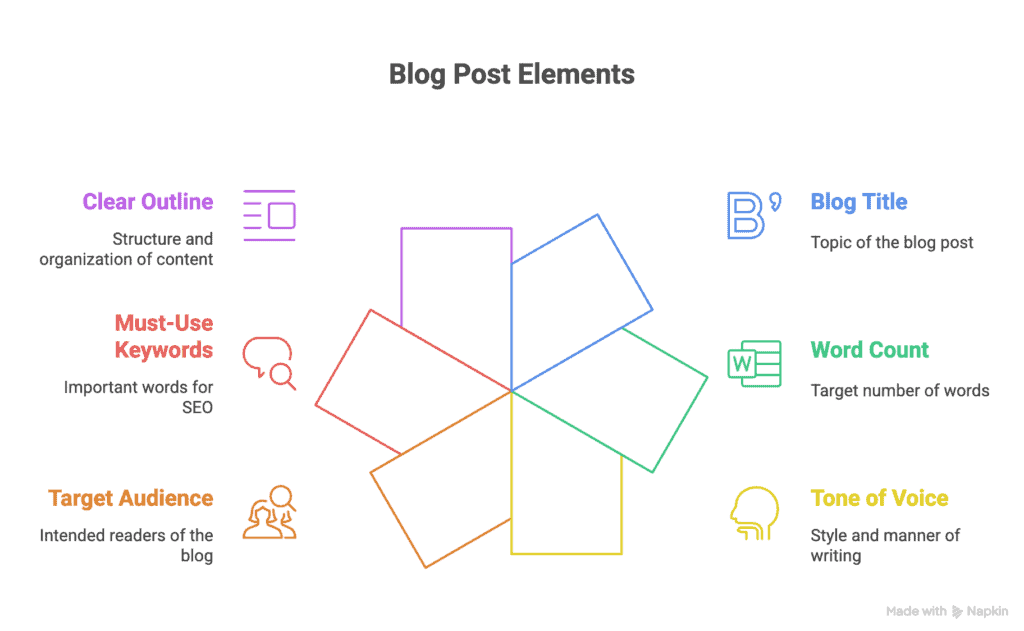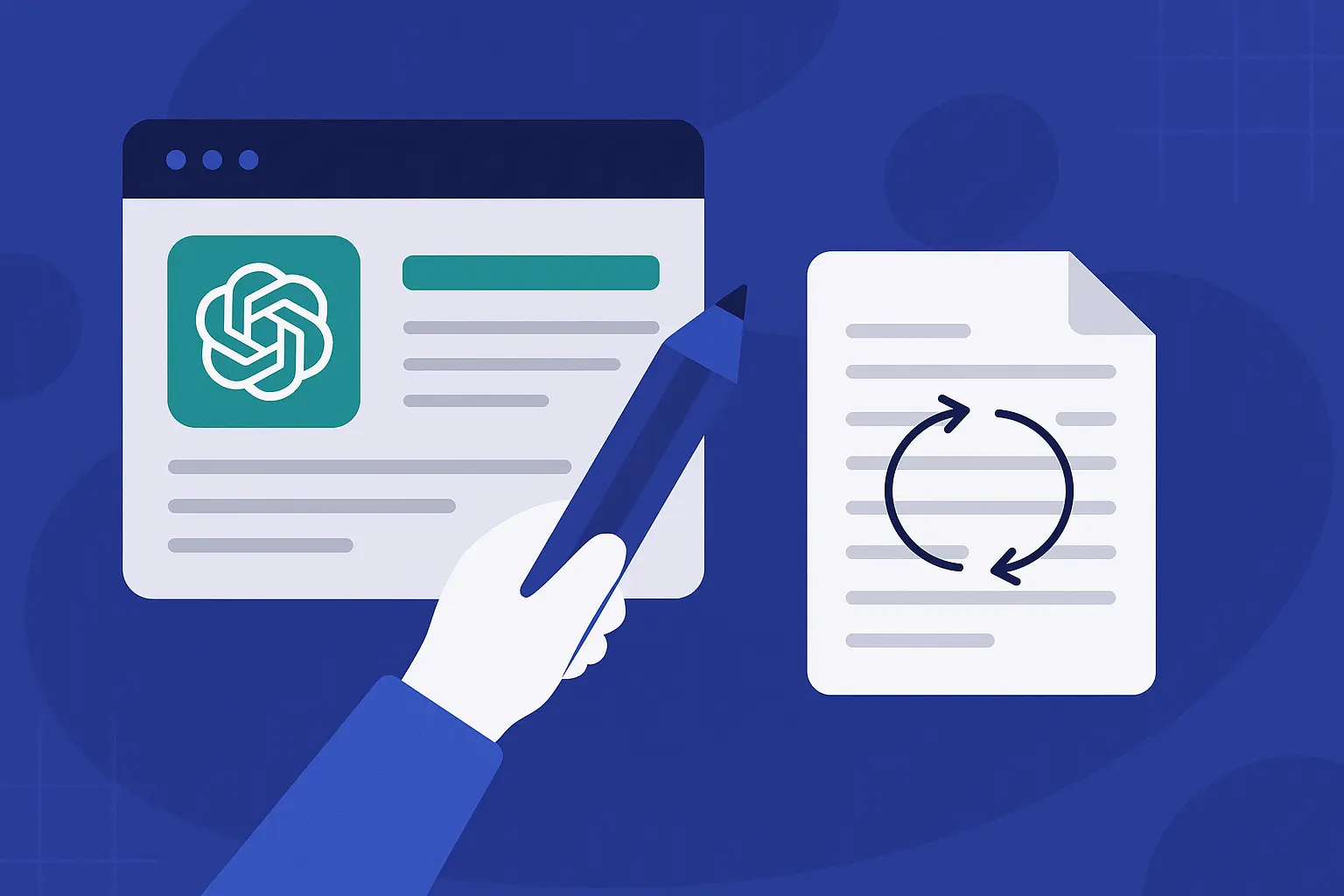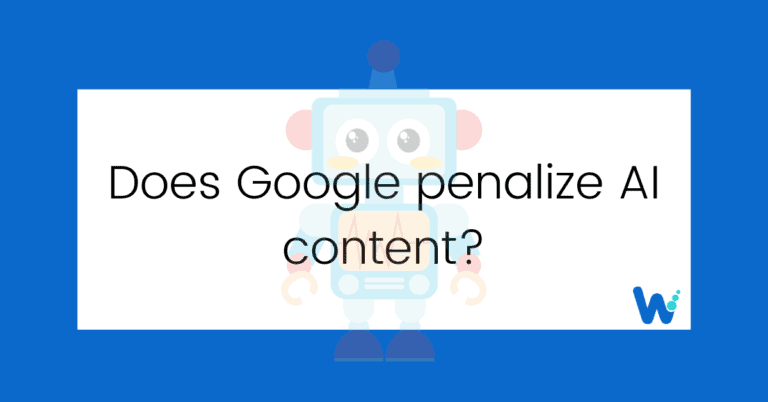Google’s Helpful Content Updates have made one thing very clear: If your blog doesn’t offer real value, you’re invisible.
Mass-produced, low-quality AI content won’t rank — even if it’s 3000 words long. Google is actively downgrading pages with:
- Repetitive structures and phrases
- Lack of originality or depth
- Obvious automation with no human editing
So if you’re using ChatGPT (or any AI tool), here’s the rule: Don’t publish what you wouldn’t read yourself. That means your content must:
- Solve a real user problem
- Offer unique perspectives or data
- Be easy to read and free of AI clichés
Now, let’s talk strategy. How do you use ChatGPT to your advantage without falling into the trap of robotic content?
Why Use ChatGPT for Blog Writing?
ChatGPT can be a content creator’s secret weapon — if you know how to use it well. Here’s what it does right:
- Saves time: It gives you quick drafts, outlines, and inspiration.
- Reduces burnout: You can focus on ideas while ChatGPT handles the typing.
- Boosts creativity: It helps unblock you when you’re stuck staring at a blank page.
But there’s a catch.
It also has a tendency to:
- Repeat phrases like “In today’s world…” or “AI is transforming the industry…”
- Sound generic or robotic
- Drift off-topic in long-form content
So how do you get the best out of ChatGPT without falling into the repetition trap?
Let’s break it down.
Step 1: Begin with a Detailed Prompt
Vague prompts give vague results. The more context you provide, the better ChatGPT performs.

✅ Here’s what your prompt should include:
- The blog title or topic
- Target word count (e.g., 1500 words)
- Tone of voice (conversational, professional, funny, etc.)
- Your target audience
- Must-use keywords
- A clear outline or subheadings (optional, but ideal)
📌 Example Prompt:
“Write a 1500-word blog titled ‘How to Start a Podcast in 2025.’ The tone should be friendly and beginner-friendly. Target audience: aspiring content creators. Use short paragraphs and avoid repetitive phrases like ‘podcasting has grown over the years.’ Include sections on planning, equipment, software, publishing, and monetization.”
Step 2: Don’t Generate Everything at Once
This is the #1 mistake most people make. When you ask ChatGPT to write a full 1500-word blog post in one go, it:
- Starts strong, but fades halfway
- Repeats sentence structures
- Uses filler phrases to meet word count
✅ Better Approach:
Break your blog into chunks. Start with:
- Intro first, then check it.
- Next, say: “Write section 1: [Subheading Title]. Keep it under 200 words and avoid generic AI phrases.”
By chunking your content, you stay in control — and your content stays sharp.
Step 3: Watch for Repetitive Phrasing
ChatGPT loves to repeat itself. It doesn’t mean to. It’s just… well, too polite sometimes.
Here are phrases to look out for:
- “In conclusion…”
- “In today’s fast-paced world…”
- “It is important to note that…”
- “This highlights the importance of…”
- Repeating the same word (like “blog” or “content”) multiple times in a paragraph
🛠️ How to Fix:
Use editing prompts like:
- “Rewrite this paragraph and remove repeated words.”
- “Make this sound more human, less robotic.”
- “Use synonyms and vary the sentence structure.”
- “Avoid using the phrase ‘X’ more than once.”
Or use post-editing tools like:
- Grammarly (for overused words)
- ProWritingAid (for sentence variety)
- Hemingway Editor (for flow and simplicity)
Step 4: Use Custom Instructions in ChatGPT (if using Plus)
If you’re on ChatGPT Plus, go to:
Settings → Custom Instructions
And fill these two fields:
What you’d like ChatGPT to know:
“I use ChatGPT for long-form SEO blog posts. I want content that’s helpful, original, and doesn’t repeat phrases. Avoid filler and always write with purpose.”
How you’d like ChatGPT to respond:
“Write like a content strategist. Keep the tone clear and professional. Use varied sentence structure and don’t repeat points unless reworded creatively.”
This subtly trains the model to follow your preferred tone and depth — especially useful when you write blogs frequently.
Step 5: Use a Strong Outline as Your Anchor
Outlines help ChatGPT stay focused. Even a simple one like this will do:
- Introduction (with a strong hook)
- Why use ChatGPT for blog writing
- Step-by-step guide to writing blogs using ChatGPT
- How to overcome repetition
- Editing and final polish
- Conclusion (with a CTA)
You can even ask:
“Give me a unique blog outline for this topic.”
Then modify the result before feeding it back section-by-section for fleshing out.
Step 6: Rewrite and Enhance for Originality
Once you get the draft, don’t publish it as-is.
Use ChatGPT again for improvement tasks:
Try these prompts:
- “Make this paragraph more engaging with a storytelling tone.”
- “Add a real-life use case to support this point.”
- “Shorten this section and make it punchier.”
- “Replace all overused words and clichés.”
This is where you move from AI-generated to human-enhanced. And that’s where the magic happens.
Step 7: Add Your Personal Touch
No matter how well ChatGPT writes — it doesn’t know your experience, opinion, or voice.
To make content stand out:
- Add personal anecdotes
- Share insights from your work
- Include original examples or stats
This instantly makes your blog valuable, and it’s exactly the kind of content Google is looking for.
Step 8: Don’t Ignore the Final Polish
Once your blog is ready:
- Read it aloud (helps catch repetition)
- Run it through Grammarly or Hemingway
- Add formatting (headings, bullets, images if needed)
- Check SEO (keyword placement, meta description, etc.)
If needed, you can ask ChatGPT to generate:
- SEO title
- Meta description
- Alt texts for images
- FAQs based on the topic
To make things easier, I’ve created a practical table you can use at every stage of your blog-writing process with ChatGPT. Whether you’re drafting from scratch or refining existing content, these prompts will help you stay focused, reduce repetition, and add real value — without getting stuck in the AI loop. Bookmark this for your next content sprint.
| Stage | Goal | Prompt Example | Bonus Tip |
|---|
| 1. Define Intent | Set the purpose, audience, and structure | “I’m writing a 1500-word blog on [Topic]. Target audience: [X]. Objective: [Educate/Rank/Sell]. Give me a detailed outline with subheadings.” | Always start with context to reduce randomness. |
| 2. Get Outline | Create clear structure before drafting | “Based on the topic [X], generate an SEO-friendly outline with 5–7 subheadings and unique angles per section.” | Ask for FAQ suggestions too — helpful for featured snippets. |
| 3. Draft by Section | Avoid repetition, increase control | “Write section 2: [Heading]. Keep it under 200 words. Avoid fluff and repetitive phrases like ‘in today’s world’.” | Use chunking to prevent long-winded or looping content. |
| 4. Fight Repetition | Diversify phrases and sentence starters | “Rewrite this paragraph to avoid repeating [word/phrase]. Use varied sentence structures and add synonyms.” | Look for repeated transitions like “Additionally” and “Moreover.” |
| 5. Add Depth | Enrich content with stats, tools, or stories | “Suggest a real-world example or data point I can add here. Keep it relevant to [section topic].” | Add 1 case study or personal anecdote per post for uniqueness. |
| 6. Polish Tone | Refine voice, remove robotic feel | “Make this sound more conversational and less robotic. Break up long sentences and remove filler.” | Add rhetorical questions or first-person POV where appropriate. |
| 7. SEO Enhancements | Optimize for rankings without stuffing | “Suggest 3 long-tail keywords related to [topic] that I can naturally integrate into this section.” | Use those keywords as subheadings or in bullet lists. |
| 8. Final Review | Run checks for flow, quality, and usefulness | “Review this blog for flow, repetitiveness, and helpfulness. Highlight anything that needs rephrasing or expanding.” | Paste full content and ask for an edit summary to quickly review suggestions. |
Conclusion: Think of ChatGPT as Your Content Team, Not Your Content Brain
If you want to generate long-form blogs that actually work:
- Guide ChatGPT like an editor
- Slice up tasks: outlining, drafting, refining, enriching
- Use prompts to fight repetition before it begins
- Add your human layer — because that’s what search engines and readers are both looking for
If you’re looking to scale your content without compromising quality, I’d be happy to help. I offer SEO blog writing services tailored to your niche, audience, and ranking goals. Whether you need long-form articles, optimized pillar pages, or topic clusters, feel free to reach out—I’ll make sure every piece is written with strategy and substance. Let’s chat about what you need.
Can I use ChatGPT to write entire blog posts for my website?
Yes, you can. However, it’s important to guide the tool with clear prompts, structure the content section-by-section, and always review and edit to ensure originality, clarity, and SEO value.
How do I stop ChatGPT from repeating phrases or ideas in long-form content?
Break the content into smaller chunks, use specific instructions to avoid repetition, and request rephrasing when needed. Also, vary your prompts and include examples of what to avoid.
Will Google penalize me for using ChatGPT to create blog content?
Not directly. Google doesn’t penalize AI-written content if it provides value to users. The issue arises when content is repetitive, low-quality, or lacks originality. Human oversight is crucial.









